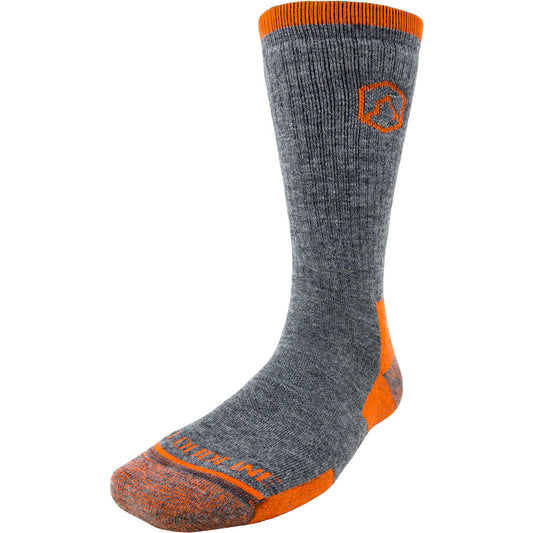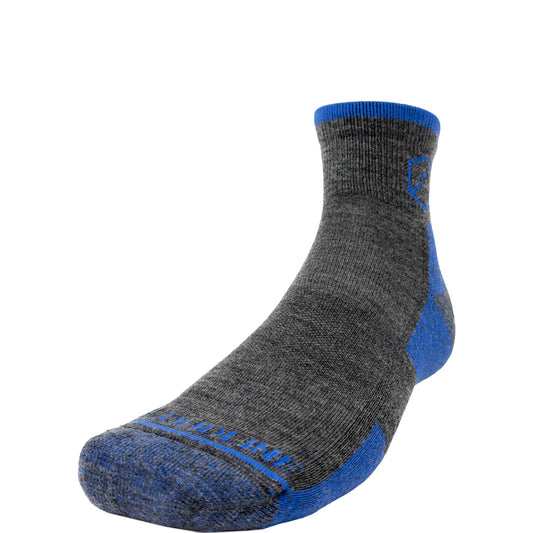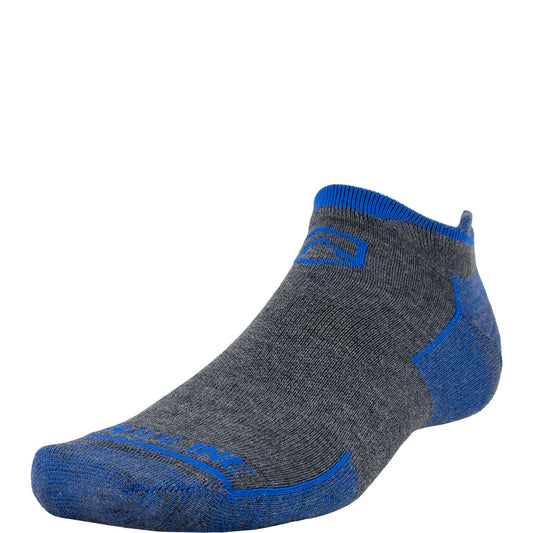
Experience All-Condition Comfort with Thermo-regulating Merino Wool Socks
Experience All-Condition Comfort with Thermo-regulating Merino Wool Socks
Ever noticed how your feet feel like they're in a sauna during a summer hike, yet turn to ice blocks when winter camping? That frustrating temperature rollercoaster ends now. Thermo-regulating merino wool socks are revolutionizing how outdoor enthusiasts experience comfort in every condition – from scorching desert trails to frosty mountain peaks.
As someone who's logged countless miles across varying terrains and climates, I've discovered that proper foot care starts with what covers them. Your adventure shouldn't be limited by uncomfortable feet, especially when the solution is as simple as choosing the right socks.
Let's explore why thermo-regulating merino wool socks are becoming the non-negotiable gear item for hikers, trail runners, and adventure seekers who refuse to let temperature extremes dictate their outdoor experiences.
The Science Behind Thermo-regulation
Thermo-regulation isn't just a fancy marketing term – it's a scientific process that explains why merino wool performs so remarkably in outdoor conditions. Understanding this process helps appreciate why these socks are worth the investment for serious adventurers.
How Merino Wool Naturally Regulates Temperature
Merino wool fibers possess an almost magical quality – they're hygroscopic, meaning they actively manage moisture at the molecular level. Each fiber can absorb up to 30% of its weight in moisture without feeling wet against your skin. This absorption happens inside the fiber structure, leaving the surface feeling dry while transporting sweat away from your skin.
The crimped structure of merino fibers creates millions of tiny air pockets that trap body heat when it's cold, providing insulation. Yet when temperatures rise, these same air pockets allow excess heat to escape, preventing overheating. This bidirectional temperature control is why merino wool socks can keep your feet comfortable in both 20°F mountain conditions and 90°F desert hikes.
"Merino wool doesn't just respond to environmental conditions – it actively manages your microclimate, creating a buffer zone between your skin and the outside world that maintains optimal comfort." - International Wool Textile Organisation research
Unlike synthetic materials that simply wick moisture, merino wool engages in a complex exchange with your skin, absorbing vapor before it becomes liquid sweat and releasing it gradually to the outside environment. This vapor management system is what truly sets merino apart from other fabrics.
Merino Wool vs. Synthetic Materials
The debate between natural and synthetic materials has persisted for years in outdoor gear circles. When it comes to socks, the differences become particularly pronounced during extended adventures.
Performance Comparison in Extreme Conditions
Synthetic materials like polyester and nylon have improved significantly over the years, but they still fall short of merino wool in key performance areas. The most glaring difference emerges during multi-day adventures when odor control becomes crucial.
Merino wool contains natural antimicrobial properties due to its lanolin content and protein structure. These elements inhibit bacterial growth – the primary cause of foot odor. I've personally tested merino wool socks through a weeklong backpacking trip without washing them, and remarkably, they remained relatively odor-free. Try that with synthetic socks, and you'll likely clear your tent of any companions!
While synthetics excel at quick-drying capabilities, they often feel clammy against the skin when wet and can develop an unpleasant chill in cooler temperatures. Merino wool, conversely, retains warmth even when damp – a crucial safety feature in unpredictable mountain environments where hypothermia remains a real concern.
The durability equation also favors quality merino wool blends. Though pure merino can wear more quickly than synthetics, modern manufacturing techniques have overcome this limitation by creating strategic blends that maintain merino's comfort while enhancing longevity.
Benefits for Different Outdoor Activities
Thermo-regulating merino wool socks aren't one-size-fits-all in terms of activities. Different outdoor pursuits place unique demands on your feet, and understanding these nuances helps select the optimal sock for your adventure.
Hiking and Backpacking
During extended hikes, your feet endure thousands of impact cycles while navigating varied terrain. The cushioning properties of merino wool socks provide crucial protection against the repetitive stress that leads to hot spots and blisters. The natural elasticity of merino fibers ensures that cushioning doesn't compress permanently over time, maintaining protection throughout multi-day treks.
Mid-weight merino wool socks with reinforced heels and toes offer the ideal balance for most backpacking adventures. The targeted cushioning prevents abrasion at pressure points while the thermo-regulating properties adapt to changing elevations and temperatures throughout your journey.
For those tackling demanding trails like the Pacific Crest or Appalachian, where resupply points are days apart, merino wool's odor-resistance becomes more than a luxury – it's a sanity-preserving necessity that allows you to carry fewer sock pairs, reducing pack weight.
Trail Running and Fast-Packing
Speed-focused activities demand lightweight socks that maximize sensory feedback while preventing blisters. Thinner merino wool running socks with minimal cushioning provide the perfect balance of protection without deadening ground feel – crucial for maintaining proper form and preventing injuries on technical trails.
The superior moisture management of merino wool becomes even more critical during high-output activities where feet can produce substantial sweat. While synthetic running socks often become slippery when wet, leading to friction and blisters, merino wool maintains its grip on your skin even as moisture levels fluctuate throughout your run.
Ultra-runners particularly benefit from merino wool's temperature stability during events that span day and night, eliminating the need to change socks as temperatures shift from sweltering afternoons to frigid pre-dawns.
Seasonal Versatility
One of the most remarkable aspects of thermo-regulating merino wool socks is their performance across all four seasons. This adaptability makes them an efficient investment for year-round adventurers.
Winter Warmth Without Overheating
In winter conditions, the insulating properties of merino wool create a microclimate around your feet that maintains comfortable warmth. Unlike cotton which becomes dangerously cold when wet, and synthetics which can feel clammy, merino wool continues insulating effectively even when damp from sweat or snow infiltration.
The temperature-regulating mechanism prevents the common problem of overheating that leads to excessive sweating and eventual chilling – a dangerous cycle in cold environments. This stability is particularly valuable during winter activities with varying exertion levels, like snowshoeing or backcountry skiing, where periods of intense effort alternate with rest stops.
For extreme cold conditions, heavyweight merino wool socks with higher wool content (typically above 70%) provide maximum thermal efficiency while still managing moisture effectively.
Summer Comfort and Blister Prevention
Counterintuitively, lightweight merino wool socks excel during summer adventures too. Their cooling properties work by wicking moisture away from the skin and allowing it to evaporate gradually, creating a natural air conditioning effect. This controlled evaporation prevents the sudden chilling that can occur with synthetic materials.
Summer hiking often involves dramatic temperature changes as you move between exposed trails and shaded forests or change elevation. Merino wool adapts to these transitions without requiring sock changes, maintaining consistent comfort throughout your journey.
The natural softness of merino fibers reduces friction against the skin – crucial for preventing blisters during sweat-inducing summer hikes. This becomes even more important when feet swell slightly in hot conditions, increasing potential friction points inside your footwear.
Caring for Your Merino Wool Socks
Quality merino wool socks represent an investment in your outdoor comfort. Proper care ensures maximum longevity and performance retention through countless adventures.
Washing and Maintenance Tips
Despite their premium nature, caring for merino wool socks isn't complicated. Machine washing is perfectly acceptable, though using cold or warm water (never hot) with mild detergent preserves the natural properties of the wool. Avoid bleach and fabric softeners, which can damage the fibers and reduce performance.
| Care Element | Recommended Approach | What to Avoid |
|---|---|---|
| Washing Temperature | Cold to warm (up to 104°F/40°C) | Hot water (damages fibers) |
| Detergent | Mild, wool-specific if possible | Heavy detergents, bleach, fabric softeners |
| Drying Method | Air dry flat or on low heat | High heat dryers, direct sunlight |
| Storage | Clean, dry, folded (not balled up) | Damp storage, tight compression |
While merino wool is naturally resistant to odors, washing after several uses remains important to remove accumulated dirt and oils that can eventually degrade the fibers. For multi-day backpacking trips, rinsing socks in stream water and allowing them to dry overnight can refresh them surprisingly well until a proper wash is possible.
Drying merino wool socks properly extends their lifespan significantly. Air drying is ideal, though tumble drying on low heat is acceptable for most modern merino blends. Avoid direct, intense sunlight which can damage the natural elasticity of the fibers.
Choosing the Right Merino Wool Sock
Not all merino wool socks are created equal. Understanding the key variables helps select the perfect pair for your specific adventure needs.
Weight, Cushioning, and Fit Considerations
Sock weight dramatically influences performance across different conditions and activities. Ultralight socks maximize breathability for hot weather and racing, while heavyweight options provide maximum insulation for winter adventures. Most hikers find midweight socks offer the versatility needed for three-season adventures.
Cushioning distribution should align with your specific activity and footwear. Full-cushioned socks provide maximum protection for rugged hiking but may feel too bulky in tight-fitting trail runners. Zone-specific cushioning targets protection where needed while reducing bulk in other areas – ideal for technical pursuits where weight and feel matter.
The merino wool percentage significantly impacts performance. Higher merino content (70%+) maximizes temperature regulation and odor resistance but may reduce durability. Modern blends incorporate nylon and spandex strategically to reinforce high-wear areas while maintaining merino's comfort benefits.
Proper sizing transcends the usual small/medium/large paradigm. Look for socks with anatomical fit features like left/right specific shaping, seamless toes, and targeted compression zones that prevent bunching and slippage – common causes of blisters during prolonged activity.
Sustainability Aspects of Merino Wool
Beyond performance benefits, many outdoor enthusiasts choose merino wool for its environmental advantages compared to synthetic alternatives.
Environmental Impact and Ethical Sourcing
Merino wool represents a renewable resource that biodegrades naturally at the end of its lifecycle, unlike petroleum-based synthetics that may persist in landfills for centuries. Quality merino wool producers increasingly commit to responsible land management practices that maintain soil health and sequester carbon.
- Biodegradable: Merino wool decomposes naturally in soil within 1-5 years
- Renewable: Sheep produce new wool annually without depleting resources
- Lower processing impact: Requires less energy to process than many synthetic materials
- Reduced microplastic pollution: Natural fibers don't contribute to waterway contamination
Ethical sourcing has become central to responsible merino wool production. Leading brands now prohibit mulesing (a controversial sheep farming practice) and implement transparent supply chains that ensure animal welfare standards are maintained. Look for certification standards like ZQ Merino or RWS (Responsible Wool Standard) that verify ethical production practices.
The durability of quality merino wool socks actually enhances their sustainability profile. Though they represent a higher initial investment than synthetic alternatives, their longer functional lifespan results in fewer replacements and less overall resource consumption over time.
Common Questions About Thermo-regulating Merino Wool Socks
Even experienced outdoor enthusiasts often have questions about these specialized socks. Here are answers to the most frequent inquiries:
Addressing Misconceptions and Concerns
Many people worry about wool being itchy, but merino wool fibers are significantly finer than traditional wool – typically under 24 microns compared to 40+ microns in regular wool. This fine diameter prevents the fibers from stimulating pain receptors in your skin, eliminating the itchiness associated with conventional wool products.
Regarding durability concerns, pure merino wool socks historically wore out faster than synthetics. However, modern manufacturing techniques incorporate strategic reinforcement through nylon and spandex in high-wear areas like heels and toes. Additionally, quality brands now offer lifetime guarantees, demonstrating confidence in their products' longevity.
The price point often raises eyebrows, with premium merino wool socks typically costing $20-30 per pair. This represents a significant investment compared to basic cotton or synthetic options. However, this cost difference dissipates when considering the extended lifespan, reduced number of pairs needed due to odor resistance, and enhanced comfort that prevents costly blister treatments and ruined adventures.
Regarding washing frequency, merino wool's natural antimicrobial properties allow extended wear between washes – particularly valuable during multi-day adventures. While synthetic socks typically require daily changes to prevent odor buildup, merino wool socks can often perform effectively for 2-3 days of heavy use before washing becomes necessary.
Whether you're planning a thru-hike on a legendary trail, a weekend backpacking trip with friends, or simply seeking all-day comfort for your everyday adventures, thermo-regulating merino wool socks provide the versatile performance that dedicated outdoor enthusiasts demand. Your feet deserve this level of care – they're carrying you toward your next remarkable experience.




